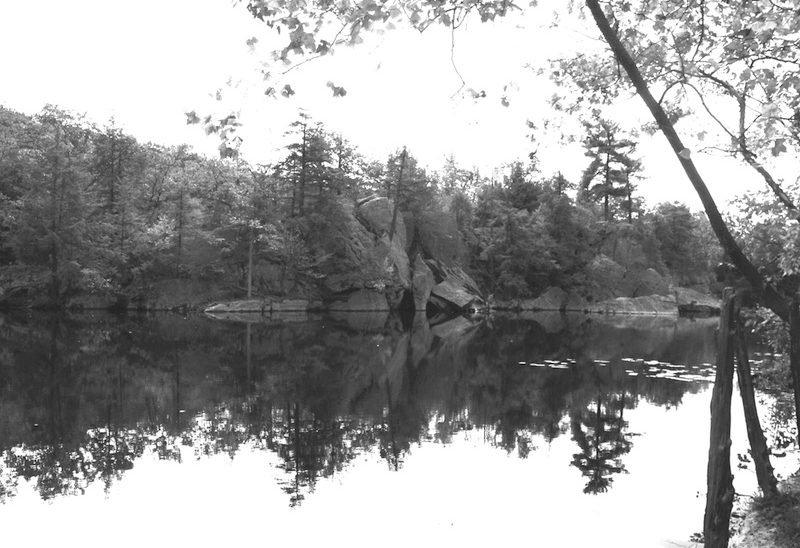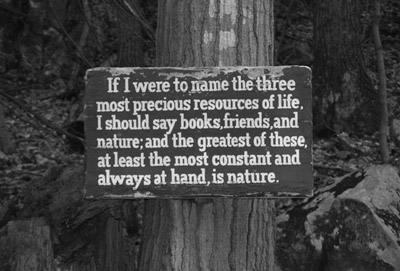
Practically Paradise
Summer 2012
Pack up all your cares and… whoa! grab your picnic basket. Have I got a great place for you!
In addition to the delightful places to picnic highlighted in Lindsay Pietroluongo’s article, there are two more not to be missed. Both are in West Park, west of Route 9W off Floyd Ackert Road. Fittingly, a series of forest trails link them as one property.
The first site, were you impossibly old, you could have shared with Theodore Dreiser, Henry Ford, Harvey Firestone, Teddy Roosevelt, John Muir, and thousands of others who tramped up the moss lined road leading to it. They came to visit John Burroughs at his cabin “Slabsides.”
The cabin’s originality is maintained: rustic, with homemade furniture, small comforts, and unkempt nature to its very doors. In it, John Burroughs wrote of this beloved untamed world outside. A world often disconnected from the multitudes of the day by their city-living ways. Disconnected that is, until Burroughs pointed out fascinating details along the path less taken, and created context for the position of all things in the bigger scheme.
“It is not customary to interview men of my vocation concerning success.”
— John Burroughs, 1898 interview by Theodore Dreiser.
Theodore Dreiser (who later authored Sister Carrie and An American Tragedy) penned his interview with Burroughs in September, 1898, when Dreiser was a journalist for Success Magazine. Dreiser’s report of his visit with Burroughs says more about the “Sage of Slabsides” than almost any other interview he gave or any lengthy biography. Perhaps that’s because the magazine sent Dreiser to interview the world-changers of his day the magazine’s focus was, after all, worldly SUCCESS in an era of Horatio Alger stories.
Dreiser weaves into the interview, in sparse but telling detail, descriptions of the cabin and its occupant, neither of which broadcast “conventional success.” What Dreiser did divine was Burroughs’ personal version of success. The journalist conveyed it admirably with his opinion, that the influential man is the successful man.
Burroughs demurred, “I have not endowed a university nor made a fortune, nor conquered an enemy in battle, he said.”
Burroughs, Dreiser opined, was certainly resource poor by the standards of great wealth held by society at large, and yet he was, as certainly, successful. In his time, Burroughs’ inspirational books connected with many a student. Burroughs lived in the rarefied atmosphere though he didn’t seem to breathe it of the nation’s most well healed men. He traveled with them on expeditions throughout the United States including Alaska. And, he did defeat an enemy ignorance of the natural world. He became the champion for stewardship of the wild long before the advent of today’s institutions that claim that role. He did all this without resorting to the power of government. He simply made you love nature as she was and that was enough to foster the attitudes of the weak and strong toward preserving her.
Today, you can sit on the porch where Dreiser waited for Burroughs to return from a walk. Where Roosevelt, Ford, and other men of the world made the sojourn to West Park to sit and enjoy the comradery of each others’ friendship. You can picnic with the spirits of potentates and the merely influential of a century ago.
The other spot of blissful quiet is the John Burroughs Sanctuary. On his death, Burroughs’ friends bought additional land near his cabin. They then formed the John Burroughs Association to honor their friend. Today, the Association is responsible for preservation of his work and his legacy, and of physical Slabsides and Sanctuary.
The Sanctuary’s central appeal for picnicking is its small lake with peninsula and huge rock falls pictured above. Recently, the beaver have felled a few large trees along the lake road. Their handiwork alone is worth taking the kids. You can watch pileated woodpeckers, kingfishers, fish, turtles, and other furtive “friends” of Burroughs.
Neither Slabsides nor the land that became the Sanctuary were Burroughs actual home, but they were certainly where his heart was much of his life.

Aside from Burroughs stature as a writer, I think there was more personal reason he was sought out, and why so many, from every walk of life and class of study, saw him as a friend. John Burroughs saw with unusual clarity the ebb and flow of all life and accepted it unadorned. From the activities of small birds to the grand plans of supermen, John Burroughs was equally comfortable and quietly observant. And, that is just how these places will affect you.
Burroughs was born on April 3, 1837 in Roxbury, NY, where he was a schoolmate of Jay Gould, another “successful” man of that era. Burroughs careers included school teacher, government clerk, and farmer, this latter was his continuing love because it kept him in touch with the land.
Burroughs lived in West Park until his death in 1921. He was buried on his 84th birthday in Roxbury on the farm to which he had been born. The tomb stone at Woodchuck Lodge, that boyhood home, is also a protected site and worth visiting.
Although the cabin, Slabsides, is open currently just twice a year, in May and October, visit it anytime, sit on the porch. Contemplate, hike, bird watch, or picnic. You can follow the trails to the Sanctuary, or go to the Sanctuary, picnic by the lake, and walk back along marked trails to Slabsides. Either way, the trees, rock formations, lake, vernal pools, ferns, lichens, mosses, flowers, birds, tiny critters, and air combine to make this place practically paradise.
To visit either site, watch for signs on the south side of Floyd Ackert road. The walk from the parking area to Slabsides is very short, while the walk into the Sanctuary is perhaps half a mile. Both are on vehicle-prohibited roads.
If you wish to know more about the John Burroughs Association and its mission, please go to their website research.amnh.org/burroughs/index.html, or pick up a rackcard with Slabsides and Woodchuck Lodge information at most kiosks in public parks.
